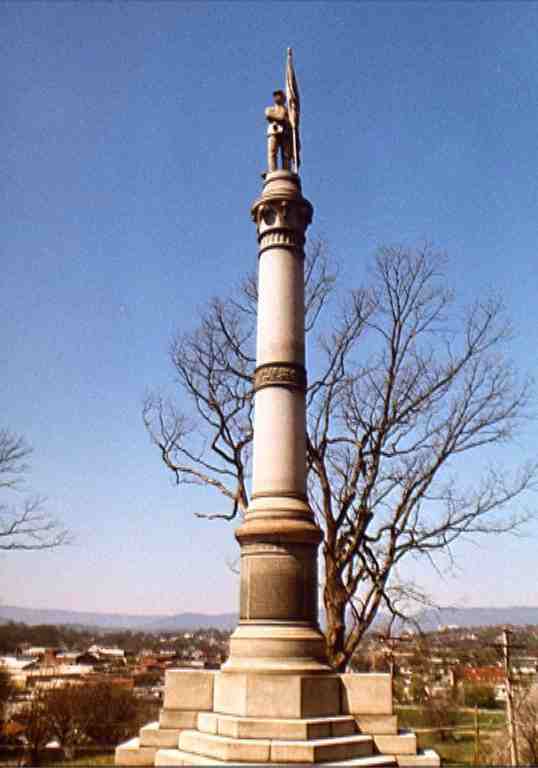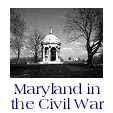

The 3rd Maryland Infantry, U.S.A. &
Latrobe's Battery, C.S.A. Monument

3rd Maryland & Latrobe's Battery Monument
Orchard Knob, Chickamauga and Chattanooga Battlefield Park, Chattanooga, Tennessee.
Photo By John Lamb
A Short History of the Monument
By John Lamb
During early 1902, Col. Benjamin F. Taylor, prominent Union veteran, and former commander of the Second Maryland Infantry and several associates were appointed by the Grand Army of the Republic to a committee to seek funds from the State of Maryland for a monument to Latrobe's Battery (C.S.A.) and the Third Maryland Infantry (U.S.A.) at the Chickamauga-Chattanooga National Military Park. Taylor and the committee appeared before the statešs Ways and Means committee in February to present a bill seeking funds for the monument. The bill was approved and $8,000 was set aside for the costs of the monument, and the Chickamauga and Chattanooga Battlefield Commission of Maryland was created. Taylor was appointed to the commission, and was elected its president in May, 1902, and along with the other members of the commission began the process of creating the monument. The commission made several trips to Chattanooga to first select and then approve the location, atop Orchard Knob, for the memorial. The Maryland Monument, atop Orchard Knob in Chattanooga was dedicated on October 8, 1903. From the Baltimore Sun, October 9, 1903 comes the following description of the monument:
"The monument is of Westerly granite and is 15 by 11 feet at the base and 44 feet high... It has three octagonal bases supporting and octagonal plinth. On the right buttress is the figure of a Confederate artilleryman, with a sponging rod grasped in the left hand and the right shading the eyes, the pose indicating that the gunner is watching the effect of a shot just fired. On the left buttress is the figure of a Union infantryman, the butt of his musket resting on the ground, the right hand in the cartridge box, as if obeying the command to handle cartridges. Each of the statues is 6 feet 4 inches high and represents accurately in every detail the uniform and equipment of the soldiers of the Civil War.
"On four sides of the plinth are polished panels, two bearing inscriptions in memory of the organizations, one showing the names of the commission, and one inscribed with a tribute from the State of Maryland to her valiant sons... At the top of the plinth is a circle of stars in bas-relief with polished surfaces, capped by a fasces band. Above this rises the main column, circled halfway up with a laurel wreath in full relief and topped with a Corinthian cap. Above the column is a base supporting the figure of a standard bearer, grasping the flag of the Union, the figure being seven feet high.
"The monument was built by the Van Amringe Granite Company, of Washington, District of Columbia."
The inscriptions mentioned above, are as follows:
"The state of Maryland, in honored recognition of the historical valor of her sons, who, in blue and gray, nobly sustained the martial glories of their fathers in the military operations around Chattanooga in the war for the union, 1861-65. The proud heritage bequeathed to worthy sons of illustrious sires rose phoenix like from the fierce fraternal strife redeemed and regenerated, and now and forever victor and vanquished are indisolubly united, knowing one God, one country, one destiny."
On the side where the artillery figure statue stood:
"Third Battery, Maryland Artillery, Confederate States of America, Capt. John B. Rowen, Lieut. William L. Ritter, Artillery Battalion, Stevenson's Division, Hardee's Corps. This battery, with its division, was assigned to the right of Bragg's line on Missionary Ridge, arriving shortly after 2 o'clock P.M. November 25. I was assigned and went into position on the crest of the ridge immediately south of the tunnel where Stevenson's division supported General Cleburne in defending his position against the assault of General Sherman. After General Bragg's line had been broken on the left and center, this battery, together with its division, withdrew under fire in good order toward Chickamauga's Station."
On the side where the infantry figure stood:
"Third Maryland Veteran Volunteer Infantry, Col. Joseph M. Sudsburg, First Brigade, First Division, Twelfth Corps, United States Army. To this regiment, with the division to which it belonged, was assigned the arduous and important duty of holding the Nashville and Chattanooga Railroad from Wartrace Bridge, Tenn., to Bridgeport Ala. The possession and keeping open of this railroad was of the highest strategical importance, constituting the main line of communication of the armies operating around Chattanooga under General Grant, thereby contributing materially to the defeat of General Bragg's army in its seemingly impregnable position on Missionary Ridge, November 25, 1863."
The monument also has inscribed upon it the names of the commission that created it: Benjamin F. Taylor, president; William Louis Ritter, vice-president; John Leonard Hoffman, secretary; William Stahl, treasurer; John Rigney King, marshal; Thomas Jefferson Canon, transportation, and Charles Wesley Hull, transportation.
Speeches were heard that day from Capt. John R. King, marshal of the Maryland Monument Commission, Col. Benjamin F. Taylor, president of the commission, Col. Joshua Herring, comptroller of Maryland, Capt. J. P. Smartt, and A.W. Chamblis, Chattanooga's mayor. It is ironic that in the news coverage of the day mention was made several times of how Orchard Knob was a safe location for a monument due to the other memorials present. In fact, Capt. Smartt assured the members of the commission that "the monument had been accepted in good faith and that the United States government's watchful sentries would ever care and protect the magnificent shaft in a most vigilant manner."
As the years have come and gone since the Civil War the memory of what occured has lost its meaning for many. National Park Service facilities and cemetaries have been subjected to many incidents of vandalism. The statues on the Maryland monument at Orchard Knob probably fell victim to such an act. They were severely damaged and were removed from the Orchard Knob Reservation to the Park Service's Chickamauga facilities.
This article is based on information on misscellaneous articles from Baltimore papers of the time, particularly the Baltimore Sun, including an article from the October 9, 1903 edition, and from the Chattanooga News , October 9, 1903.

| 
| 
| 
| 
|